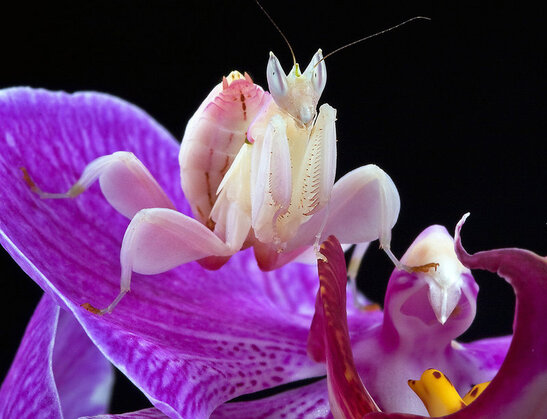|
Better-GroOrchidBlog
 Photo Credit: NPR Photo Credit: NPR There are many different orchids that display a wide array of appearances within the Orchidaceae family. Some of the more exotic-looking orchids resemble animals. The monkey face orchid, flying duck orchid, hedgehog face orchid and bee orchid all bear a remarkable resemblance to the animals they’re named after. Mimicry isn’t a one-way street, though. While some orchids grow to look like animals, one insect matures to resemble orchids. Unless you look closely, you could even mistake the orchid mantis for a flower. Looking Like an Orchid
The orchid mantis is a species of praying mantis that models itself after a flower, specifically a pink orchid. Its scientific name is Hymenopus coronatus. The mantis is white with pink accents, which vary from soft to bright, and its legs have lobes that make them look like the petals of an orchid. Its size is even about that or an orchid flower, with females growing to be about 2.5 inches, and adult males measuring about 1 inch. Most impressive, the mantis can vary its color with certain environmental conditions, namely changes in light or temperature, so that it resembles not just an orchid in general but the specific orchids that it’s living near. Living Like an Orchid The orchid mantis doesn’t just look like an orchid, but, in many ways, it also lives like one. The insect is native to Malaysia, where plenty of orchid species (including pink ones) come from. In Malaysia, the mantis is found in bushes and on trees -- the same places where epiphytic orchids grow. (Epiphytes are plants that grow harmlessly on other plants.) The mantis even likes the same weather as orchids, preferring daytime temperatures between 77 and 95° F, and needing nighttime temperatures to be at least 64° F. It also requires high humidity levels, ideally a relative humidity between 60 and 70 percent. Staying Safe While Hunting Insects By resembling an orchid and living in the same places where an orchid would, the orchid mantis is able to hide from predators and hunt its prey. Birds will overlook the sizeable insect, mistaking it for a flower. Smaller insects will too, coming too close to the predator. The mantis will eat small butterflies, hoverflies, houseflies, crickets and other, similar insects, which are all attracted to the pink orchid the mantis resembles. Learning about orchids is a never-ending pursuit, and the field of study isn’t limited to the flowers themselves. To learn more about orchids, their relationships with insects and orchid care, visit EasyOrchidGrowing.com. Happy Blooming! Comments are closed.
|
Resources
|
Company |
|
